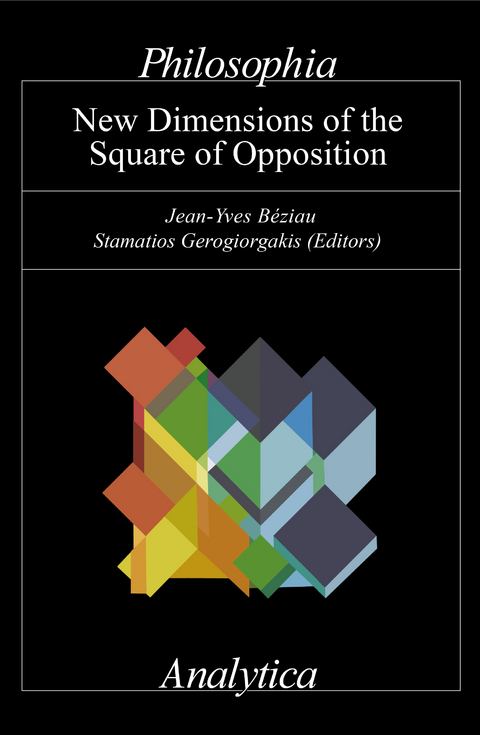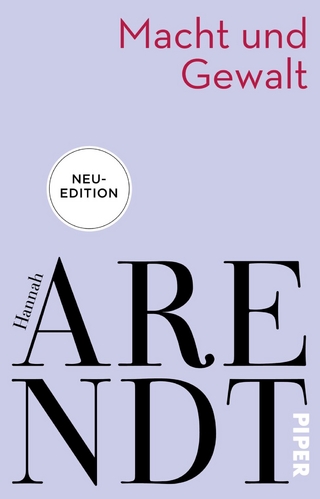
New Dimensions of the Square of Opposition
Philosophia Verlag
978-3-88405-112-2 (ISBN)
Jean-Yves Beziau is Professor of Logic at the department of philosophy of the Federal University of Rio de Janeiro and titular member of the Brazilian Academy of Philosophy. He has a PhD in Philosophy and a PhD in Mathematical logic. He has developed the field of universal logic, organizing world events on this topic and he has renewed the studies on the square of opposition organizing also world events on 13 this topic.
Stamatios Gerogiorgakis (PhD LMU Munich, Dr. phil. habil. University of Erfurt) is 'Privatdozent' at the University of Erfurt. His work ranges from the history of logic to the philosophy of religion and from metaphysics to semantical paradoxes. He blogs at: www.philori.de
Table of Contents
Jean-Yves Béziau / Stamatios Gerogiorgakis
The Many Dimensions of the Square of Opposition
Introduction9
1 HISTORICAL AND CRITICAL ASPECTS OF THE SQUARE
Paul J.E. Dekker
Heraclitean Oppositions19
Juliette Lemaire
Is Aristotle the Father of the Square of Opposition?33
Stamatios Gerogiorgakis
A Vindication of a secundum-quid-et-simpliciter Solution of the Paradox of Epimenides
by Way of Mereological Hexagons71
Enrique Alvarez and Manuel Correia
Conversion and Opposition: Traditional and Theoretical Formulations87
Régis Angot-Pellissier
Taoist Logical Hexagon. The Philosophical Meaning of 3-opposition
and Weak 2-opposition in Cosmology107
2 THE SQUARE OF OPPOSITION AND NON-CLASSICAL LOGICS
Ka-fat Chow
Opposition Inferences and Generalized Quantifiers155
Claudio Pizzi
Contingency Logics
and Modal Squares of Opposition201
Christan de Ronde, Hector Freytes and Graciela Domenech
Quantum Mechanics and the Interpretation of the Orthomodular Square of Opposition 221
Luca Tranchini and Michael Arndt
A Constructive View of the Square of Oppositions 241
Fatemah Ayatollah Zadeh Shirazi
2n-polygon of Opposition and 2n-tuples Satisfying It 275
3 APPLICATIONS OF THE SQUARE OF OPPOSITION
François Nicolas
The Hexagon of Opposition in Music299
Jean-Yves Béziau
Opposition and Order 321
Jonas R. Becker Arenhart and Décio Krause
Oppositions and Quantum Mechanics: Superposition and Identity337
Katarzyna Gan-Krzywoszyńska
and Piotr Leśniewski
An Erotetic Hexagon: Oppositions as a Basis for the Logic of Questions355
Fabio Tfouni
Interdiction and Silence: A Traditional
Reading of the Square of Opposition377
Index
Abstracts / Authors’ Short Biographies
Jean-Yves Béziau Stamatios Gerogiorgakis The Many Dimensions of the Square of Opposition Introduction The square of oppostion is a two-dimensional diagram that can be extended in various ways: as a polygon (hexagon, octagon, decagon, etc.) or as a polyhedron (cube, cuboctahedron, bi-simplex, etc). Some of these geometrical extensions are dicussed in this book, in particular Blanché’s hexagon which undoubtedly was a major improvement of the square and a decisive step for the development of new directions in the theory of logical opposition. The idea of Blanché’s hexagon, fully presented in his book Intellectual Structures (1966), is not a straightforward geometrical generalization of the square such as a cube of opposition. It is a clever reconstruction of the square solving many problems related to the theory of opposition as systematized and depicted by Boethius in a square diagram based on Aristotle’s ideas about opposition, concept and quantification. Moreover, Blanché has shown how the hexagon can be used to articulate the understanding of many notions, promoting this figure as a basic tool for conceptual analysis. This hexagon built as a contradictory entanglement of a triangle of contrariety and a triangle of subcontrariety is a powerful structure that can generate more abstract geometrical objects and can be applied to the most various notions, ranging from music to economy, from religion to mathematics, quantum physics to psychoanalysis (see Béziau 2012a). Such a figure of opposition reflects and unifies the many dimensions of human mind in connection with reality. The square of opposition can be understood in two different ways: (1) as a diagram, (2) as a theory of opposition. The relation between these two meanings varies quite a lot and there is also an interaction between the theory and the diagram. There is a theory very close to Aristotelian notions of logic and Boethius’s diagram. This theory is based on the four types of categorical propositions and described by the following version of the square: The four corners of this square are traditionally abbreviated by the four letters A, E, I, O. This leads to a more abstract picture: This skeletal diagram with these cryptographical abbreviations corresponds to an abstract structure that can be interpreted in many different ways going far beyond the original four categorical propositions and that can be generalized to other geometrical structures of opposition, such as Blanché’s hexagon with two more vertices U and Y which are respectively the disjunction of A and E and the conjunction of I and O: Some problems like the question of existential import are related to some interpretations of the original particular version of the square of opposition encompassing categorical propositions and they do not make sense on the abstract level, like any neo-medieval talks related to the dance of angels on one of the corners of the square would not. On the other hand, the abstract generalization of the square has shown that some strange aspects of the square such as the O-corner (about this mysterious corner, see Horn 2012) can be understood in the light of some challenging modern logics, like the paracaconsistent turbo polar logic of Newton da Costa (see Béziau 2003). And, conversely, the square has shed some light on such exotic logic establishing a connection between it and more traditional systems, like S5 or other modal logics (see Béziau 2005 and 2012b). The expression “square of opposition” can nowadays be considered as a name for a theory of opposition which has many interpretations and which is developed using many different diagrams that are not “squares”. The reason to stick to “square” is just to keep the connection with the first formulation of the theory where we can already find the three notions of opposition and the adjunct notion of subalternation. It is also possible to use the expression “geometry of opposition” or better “geometry of logical opposition” as promoted by Moretti (2009). The square of opposition is a theory mixing mathematics, logic and philosophy. The central notion is opposition, logically defined by the dichotomy truth and falsity. This dichotomy generates a trichotomy of oppositions: contradiction, contrariety and subcontrariety which can be viewed itself as a triangle of contrariety. And one may also use a triangle of contrariety generated by this dichotomy to generalize the dichotomy truth/falsity in terms of a trichotomy truth/falsity/undetermined. The logic and metalogical levels are interacting (see Béziau 2013). It is possible to go on constructing a square, a pentagon, a hexagon, a heptagon, an octagon, a decagon, etc. of contrariety going from dicho¬tomy to any polytomy along a line similar to what has been done in many-valued logic. We can consider a contrariety chili-agon of opposition and reaching infinity, an apeirogon, or a circle. It is interesting to consider a circle as the limit at infinity of a contrary polygon, because in this case the figure resulting from its combination with its dual subcontrariety twin is a similar object, i.e. a circle (we can also consider two spheres combined into another sphere). In case of a finite polygon, the assemblage of the two dual figures is a different polygon of double number of vertices: starting with Blanché’s hexagon which is the assemblage of a triangle of contrariety with a dual triangle of subcontrariety, going on with an octagon, assemblage of two squares, etc. Such figures resemble more and more a circle. Here is for example the deontic octodecagon of Paul McNamara (2006, 274): From a square of opposition we can naturally reach an interesting circle of opposition. Square and circle are opposed in some way, but the theory of the square of opposition clearly shows that square and circle are not a contradiction because something can be neither a square nor a circle, for example, a triangle. According to the square of opposition, square and circle are just a contrariety. It is in fact funny that the most common example of contra-diction which is usually given, a round square, is not a contradiction, but a contrariety. This indeed shows that despite the fact that the notion of contrariety was promoted by Aristotle more than 20 centuries ago, it is still not a clear and distinct idea for most of the people. This is reflected in natural language where “contrariety” is not part of the lexicon and where “contrary”, which is close to it, is mostly synonymous with “contradictory” meaning diametrically opposed. Literally speaking, this expression means opposed in the strongest way, since the diameter is the longest distance between two points of a circle. In the square the longest distance is the diagonal, corresponding to contradiction in the square of opposition. However, it is not usual to say that two things are diagonally opposed (the diagonal is related to some proofs using the reduction to the absurd, but this is an-other story). In some sense we still think most of the time in a dichotomic way: good vs. bad, beauty vs. ugliness, bachelorhood vs marriage etc. All this sounds like odd and even, straight and curve, finite and infinite, basic dichotomies of the Pythagorean table which were used to explain everything in the world. Going from dichotomy to any polytomy, we may loosen the strength of opposition reaching flabby difference, a kind of indifferent opposition, like salt and pepper. That would be a reason to defend a triangular view of opposition, considering that triangularity is enough to think that every system of thought can be reduced to a triangular articulation in the same way that any system of signs can be reduced to a binary system: 0 and 1, or any other pair of two signs. Not every difference is an opposition but opposition does not reduce to contradiction – this is clear since Aristotle. It is difficult to adhere to Kant’s position (1800) claiming that only dicho¬tomy is a priori and other polytomies are empirical. But defending trichotomy we can agree that a quatritomy like earth, wind, water and fire, the so-called elemental square, is empirical and is not a real square of opposition, in the same way as other polygons of fake opposition. The papers in this volume touch these questions in one way or another. Most of these papers were presented at the 3rd World Congress on the Square of Opposition that took place at the American University of Beirut on June 26-30, 2012 in Lebanon, an interdisciplinary event gathering researchers from all over the world, in continuation to a series of events, following the 1st World Congress on the Square of Opposition (Montreux, Switzerland, 2007) and the 2nd World Congress on the Square of Opposition (Corte, Corsica, 2010). Our thanks go to the local organizers of SQUARE 2012: Ray Brassier, Wafic Sabra, Hiba Hammoud as well to all the par-ticipants of this event. REFERENCES Béziau, Jean-Yves (2003) “New Light on the Square of Oppositions and its Nameless Corner”, Logical Investigations 10, 218-232. Béziau, Jean-Yves (2005) “Paraconsistent Logic from a Modal Viewpoint”, Journal of Applied Logic 3, 7-14. Béziau, Jean-Yves (2012a) “The Power of the Hexagon”, Logica Universalis 6, 1-43. Béziau, Jean-Yves (2012b) “The New Rising of the Square of Opposition”, in J.-Y.Béziau & D. Jacquette (eds.), Around and beyond the Square of Opposition, Birkhäuser, Basel, 6-24. Béziau, Jean-Yves (2013) “The metalogical hexagon of opposition”, Argumentos 10, 111-122. Blanché, Robert (1966) Structures intellectuelles. Essai sur l’organisation systématique des concepts, Vrin, Paris. Horn, Laurence R. (2012) “Histoire d’*O: Lexical Pragmatics and the Geometry of Opposition” in Béziau, Jean-Yves & Payette, Gillman (eds), The square of opposition - A general framework for cognition. Peter Lang, Bern, 393-426. Kant, Immanuel (1800) The Jäsche Logic, in Kant, I., Lectures on Logic, transl. & ed. by J. M. Young, Cambridge University Press, Cambridge. McNamara. Paul (2006) “Deontic Logic”, in Gabbay, Dov & Woods, John (eds.), Handbook of the History and Philosophy of Logic, Volume 7, North-Holland, Amsterdam. Moretti, Alessio (2009) The geometry of logical opposition, PhD Thesis, University of Neuchâtel. Seuren, Pieter (2010) The Logic of Language. Volume II: Language from within, Oxford University Press, Oxford.
| Erscheinungsdatum | 16.06.2017 |
|---|---|
| Reihe/Serie | Analytica |
| Verlagsort | München |
| Sprache | englisch |
| Maße | 150 x 220 mm |
| Gewicht | 733 g |
| Einbandart | Leinen |
| Themenwelt | Geisteswissenschaften ► Philosophie |
| Schlagworte | Linguistics • Mathematics • Philosophy |
| ISBN-10 | 3-88405-112-1 / 3884051121 |
| ISBN-13 | 978-3-88405-112-2 / 9783884051122 |
| Zustand | Neuware |
| Haben Sie eine Frage zum Produkt? |
aus dem Bereich


